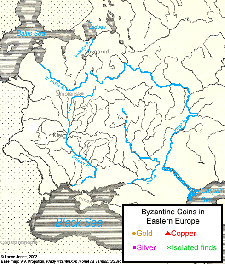|
|
||||
|
Evidence from a Chinese tomb
The tomb of an important individual, Tian Hong (d. 575 CE), located in Ningxia in northwest China, contains five gold coins issued by the rulers of the East Roman (Byzantine) Empire from their capital at Constantinople (Istanbul in modern Turkey). The images and inscriptions on the coins date them—the earliest from Emperor Leo I (457-474) and the latest from the reign of Emperor Justinian I (537-542), when Byzantium reached its height of power and wealth. Identifying and dating these coins is relatively easy because the numismatic history of Byzantium is well known. Analyzing them historically is a more complex task.
One of these gold coins was issued by Justin I and Justinian I as co-emperors in the only year when they shared the throne, 527 CE. The front (obverse) shows the two emperors seated on a throne, each holding symbols of power—an orb for the world they rule and a scepter. Above them is a cross, and the Christian basis of their state is further emphasized by the image of a standing angel on the reverse holding a cross in one hand and an orb with a cross in the other. The inscriptions in Latin give the emperors' names and an invocation to victory. Words also indicate that the coin was minted in Constantinople. The coin is less than standard weight because it has been clipped around the edges (an illegal, yet lucrative, practice). Of particular interest are the four holes drilled in the coin at some point after production.
The second coin was issued by Emperor Justinian I. Its obverse shows a half figure of him holding a cross, and the reverse has an angel similar to the one described above. This one has been clipped, but not pierced.
The interesting historical questions about these coins relate to how they reached China, why, and how they were used. Four of the five coins in the tomb have been pierced, suggesting decorative use, perhaps jewelry. One of the coins was found in the mouth of the skeleton, reflecting a common belief in Eurasia that payment ensured transport for a dead soul.
We can reconstruct possibilities as to how the coins might have come to China from Western Asia. We know from Byzantine sources that in the time of Emperor Justinian I, the Byzantines exchanged emissaries with the Turks who ruled Central Asia. Yet Byzantine coins in China are very rare. If western coins were used for exchange, they were probably Sassanian ones from Iran. These were found in large numbers, but only in the western part of what is today China.
These Byzantine coins provide one kind of evidence about China's contacts with the West. We learn from the coins that foreign objects may have been considered "exotic" and may have had decorative or religious functions. Additional proof of their decorative value can be seen in imitations made in Central Asia. Stamped out of thin sheets of gold, these copies did not have the weight or monetary value of a real coin. Yet some were found in 6th-century Chinese tombs, implying that even an imitation held value.
Byzantine Coins and Their Arab Imitations
The Byzantine gold solidus was the “dollar” of its day in western Eurasia. From its creation in the 4th century, the weight and purity remained constant, guaranteeing its value for commercial transactions. With the rise of Islam in the 7th century, new Arab rulers wished to distinguish themselves from the Byzantines, whom they had conquered. Coins provided one way of doing so. Evidence from Caliph Abd al-Malik (685-705), who ruled in Damascus, offers interesting insight into this issue.
The obverse of one example from the rule of Abd al-Malik, shows a ruler dressed in traditional Arab headdress and robes, standing with a sword. The reverse has a stepped platform with a pole or pillar. The inscriptions, in Arabic, include the Muslim declaration of faith and the date in the Muslim calendar AH 76. A second coin of Abd al-Malik the following year is strikingly different. Images have been replaced by Arabic inscriptions, and the coin weighs less than the Byzantine standard.
Human images on early Arab coins are remarkable because Islam prohibits human representations. In this period, however, the restrictions were still being formed, and these coins imitate contemporary Byzantine ones with a picture of the ruler. The platform and pillar are also revealing. Byzantine coins have a platform with a cross; in these coins, the crossbar has been removed, changing a religious Christian symbol into a pillar.
This example shows how images on coins are important expressions of beliefs and symbols of power. Muslim caliphs wanted coinage with their own distinctive symbols, distinct from the former Byzantine rulers. Arabic inscriptions asserted Islamic faith, further distinguishing the new rule. The coins offer striking evidence of important issues involved in the formation of a distinct Arab Muslim identity.
Byzantine Coins and Trade in Eastern Europe
In the example from China, we considered the symbolic value of Byzantine coins. Yet we often think of coins as money with an economic function. Coins can also provide evidence about the role of money, trade routes, and change over time. However, the economic evidence of coins must be analyzed carefully. An isolated example of a coin may reflect chance. Datable coins found in large numbers in well-defined regions are a different matter and may document patterns of distribution. Coins minted in one location and found in another may reveal patterns of production and trade.
 [Click picture for interactive map]
What does this evidence tell us? Much has been written on connections between early Russia and the Byzantine Empire. Standard histories date the beginning of the trade route from the Varangians (Scandinavian Vikings) to the Greeks (the Byzantine Empire) through European Russia to the 9th century. This view, however, is based primarily on a chronicle written several centuries later and is unreliable for information on the 9th century. The Byzantine coin finds in Russia instead suggest that a trade route up the Dnieper River past Kiev and on to the Baltic Sea began closer to the end of the 10th century and then flourished for more than a century. Coins provide a good starting point for learning about that trade. A broader understanding comes from looking at a wide range of material, including objects that formed part of the trade. |
||||||||||
|
finding world history | unpacking evidence | analyzing documents | teaching sources | about |
||

